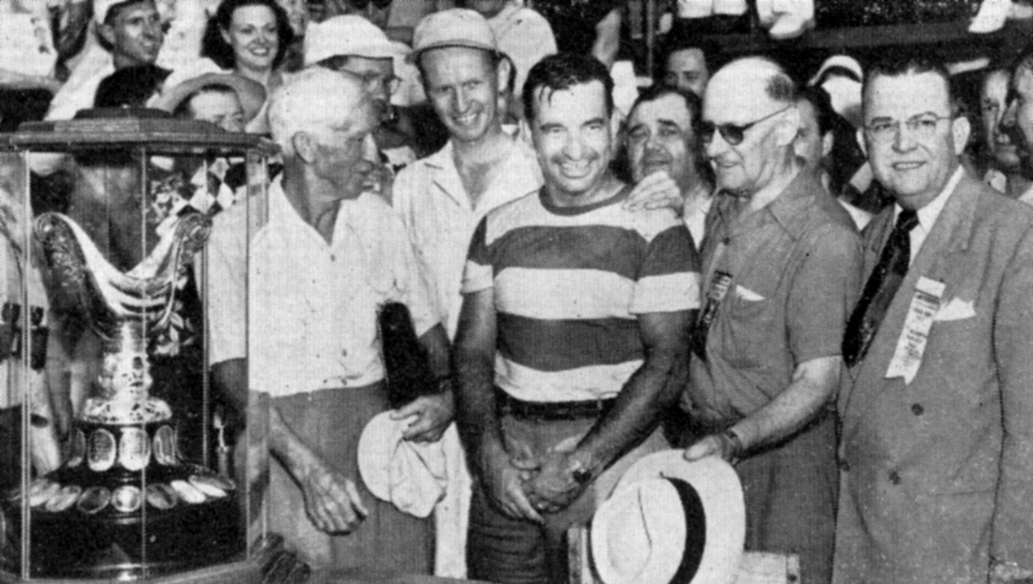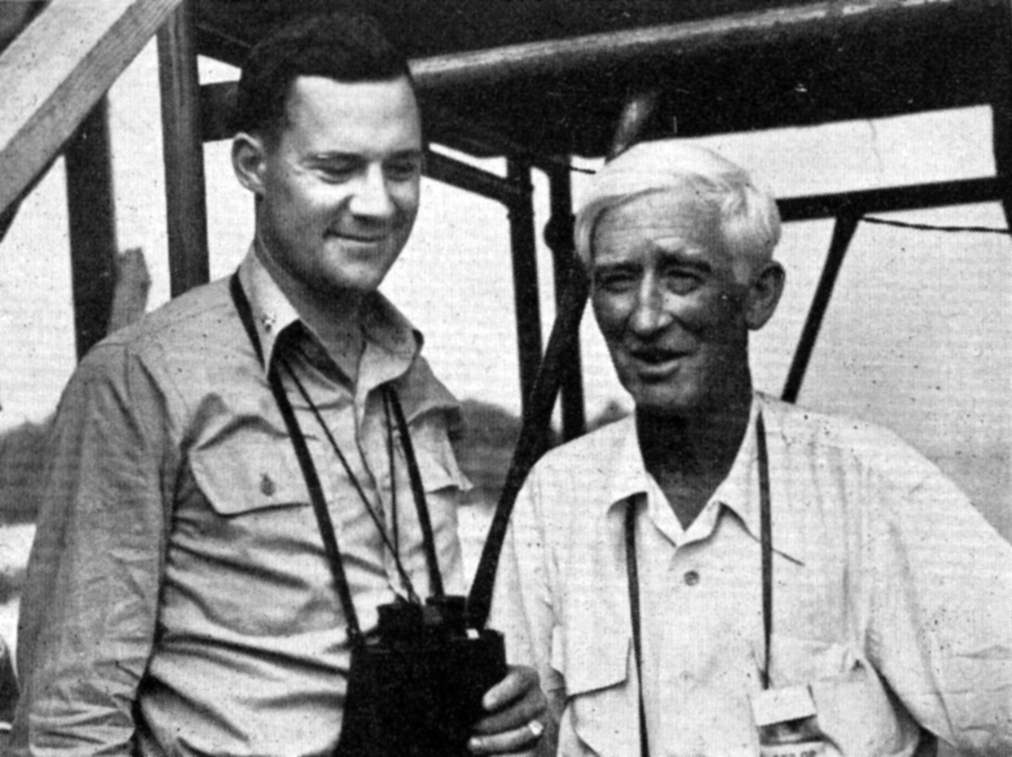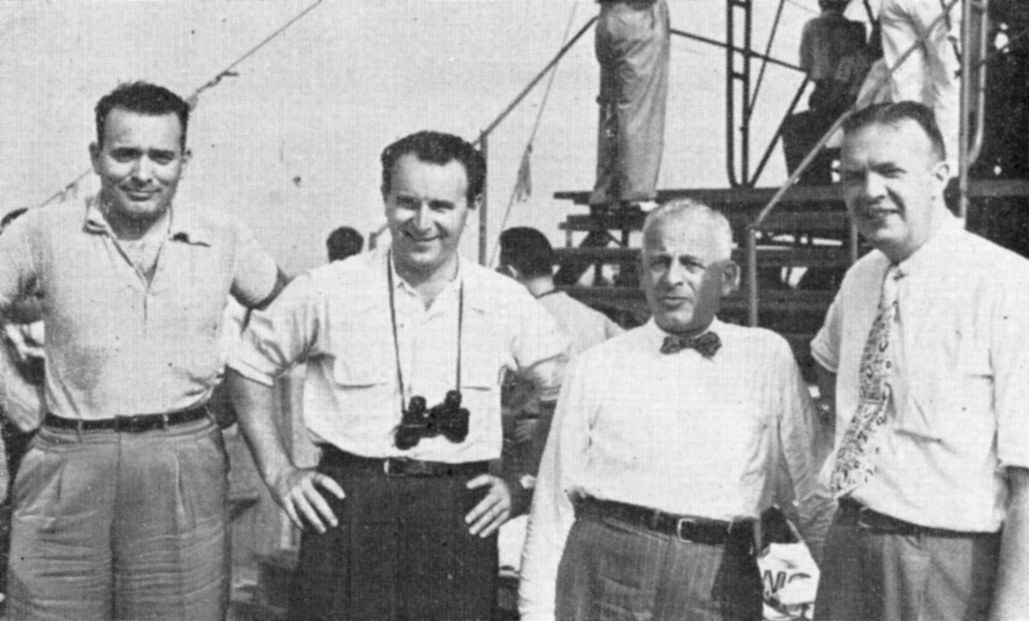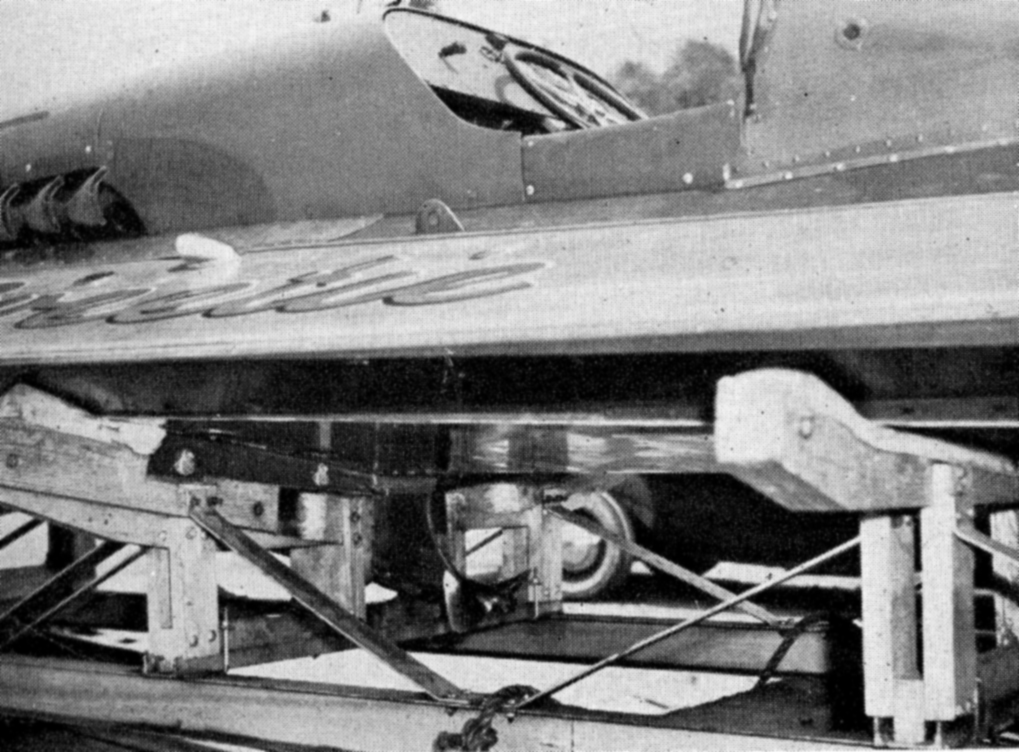1949 APBA Gold Cup
Forty-second Gold Cup Regatta
By Victor Oristano; Photographs by Rosenfeld

owned and driven by R. Stanley Dollar, Jr.
Not in all the forty-five year history of the Gold Cup, formally known as the American Power Boat Association Perpetual Challenge Cup (for boats under forty feet), have four boats raced ninety miles at such speeds and with such competence as on Saturday, July 2, on the Detroit River. With the city a steaming cauldron of humidity and the temperature at an uncomfortable 101 degrees Fahrenheit, the water flattened out with only a southeasterly zephyr to fan the faintest ripple on a course which has been known for its turbulence.

John L. Hacker and King Brugman
Four sturdy craft finished in one of the most satisfying unlimited class races of all time. First, My Sweetie, owned by Ed Schoenherr and Ed Gregory of Detroit, with Bill Cantrell, the Louisville, Kentucky, veteran boat and automobile driver at the wheel. Second, Skip-A-Long, with owner R. Stanley Dollar, Jr., of Walnut Creek, California, driving, and Ollie Meek, also of Walnut Creek, riding as mechanic. Third, Such Crust, owned by Detroit sportsman Jack Schafer and driven by Dan Arena, one of motor boating's outstanding figures, with brother Gene as mechanic, both of Kent, Ohio. Fourth, Joe Van Blerck, Jr., replacing Guy Lombardo at the wheel of three time champion Tempo VI, originally My Sin.

The changes in the Gold Cup rules made in January, 1949, called for qualifying trials in which every potential contestant had to run three laps at an average speed of not less than sixty-five miles an hour. There was no latitude granted the race committee to permit untried boats to compete, as had frequently occurred in the past.
The recognized and well known "colossal clunkers" and alleged "mystery" boats which have cluttered Gold Cup Race fields in the past were swept from the scene in the four days of trials prior to the big event, and the ten boats in the race charged the atmosphere with a spirit of keen competition.

Of the thirty-five entries twenty attempted to qualify and ten did so. Nine of these started in one or more heats, and four of the nine ran the full ninety miles. All of these factors created precedents in Gold Cup Race competition.
In the qualifying round Bill Cantrell drove the glistening mahogany Hacker designed and built two-step hydroplane My Sweetie to a 92.402 mile an hour average for the three laps. Closest to him was Dollar in his all aluminum Skip-A-Long, with average qualifying speed of 84.373 miles an hour for the same distance. Lou Fageol's seven liter class So-Long was the only qualifier which did not start in the Gold Cup. As Lou explained it, there was no point in running in a field in which he was so outpowered, especially considering that there was a seven liter class race coming up on Monday, July 4.
On Friday night qualifier Astraea II, designed and built by Douglas Van Patten and driven by owner D. Cameron Peck of Chicago, broke a bearing in the propeller shaft and was able to run only five laps in the second heat. On Saturday morning Tempo VI fused her shaft with a strut, breaking the shaft and strut. A corps of mechanics under the direction of Lombardo and racing pal Joe Van Blerck, Jr., whose own Aljo was half a lap from qualifying on Friday when she broke a connecting rod, hurriedly set a spare shaft and a new heavier strut in place. The heavier strut caused the graceful Tempo VI to develop a tremendous amount of torque and cut several miles off her speed.
The first heat for the Gold Cup started at 2:05 p.m. and eight of the ten qualifiers came to the starting line. Astraea and So-Long remained in their pits.
Such Crust, Hurricane [IV] (driven by owner Morlan Visel of Los Angeles), Skip-A-Long and My Sweetie were bunched at the start, all blazing down the stretch at practically full throttle. At the first buoy, about 750 feet from the starting line. Hurricane had almost a full length lead, but Cantrell was determined to he in front at the turn and not get boxed in among the tightly clustered field. Hurricane was overtaken when approaching the turn and neatly "hosed down" by the veteran Cantrell.
The field began to spread on the first lap and Cantrell still had My Sweetie in front as he was going into the first, or west, turn again on the second lap. Suddenly, at the apex of the turn My Sweetie reversed herself, swapping ends as an automobile does on a banked track, and stopped dead. Later Cantrell explained that his foot throttle broke.
Skip-A-Long, the snub nosed aluminum giant which had started in third position, took over at this point and began a neck and neck fight with her California cohort, the gleaming white and blue one piece sponson-less hull driven by Visel, who is an outstanding 135 cubic inch hydroplane driver. For the next two laps of the two and one-half mile course (laid out by the Coast Guard and the sponsoring organization, the Detroit River Racing Association) Hurricane held her own against Skip-ALong, taking the lead on the south side or down stretch opposite the starting line at the Whittier Hotel. But each time the boats came around the east end buoys Dollar would dig his wide port sponson into a tight turn and take the lead across the finish line or north side of the course.
Hurricane slipped back into third position on the fourth lap, being supplanted by Dan Arena in Such Crust, the well balanced, Ventnor-built, mahogany, three point hydroplane.
At the end of the fourth lap Hurricane returned to the pits, a victim of a broken gas line. From the fourth lap on it was Skip-A-Long first and Such Crust a close second until the tenth lap. On the fifth turn Dollar had lapped Tempo VI, Hot Metal and Miss Great Lakes, while Arena was pacing Such Crust beautifully, never permitting Dollar to advance more than 500 to 750 feet ahead of him. At any rate Dollar maintained his lead to almost the end of the tenth lap. At this point Skip-A-Long foundered momentarily in the wake of two lapped boats and Such Crust made her bid. While Dollar had been pacing the field with laps of seventy to seventy-seven miles an hour, Such Crust quietly and smoothly added a few hundred r.p.m's, "cruising" the two last laps at speeds of 80.142 and 81.059 miles an hour.
As Harry Lynn, owner-driver of the ill fated LaHaLa which threw a wheel into her stern while coming to qualify, said later, "The Arena boys were riding in their parlor." Never once did they seem to exert themselves or their Allison power plant.
Because the A.P.B.A. record book shows only a three mile lap record of 77.911 miles an hour for the Gold Cup Race, Arena's top lap speed was assumed to be superior to any previous two and one-half mile Gold Cup Race lap speed. Danny's average for the regulation thirty mile heat was positively a new Gold Cup record, 74.809 miles an hour, as against the best previous speed of 70.878 made by Lombardo in Tempo VI on the same course on September 2, 1946, with her original Miller-Zumbach 725 cubic inch engine which now powers Joe Van Blerck's Aljo.
While the Arena-Dollar match was the cynosure of the 150.000 spectators' eyes, Cantrell was not without accomplishment. A few minutes after his foot throttle collapsed Cantrell had My Sweetie running again. As he later explained, he could get only 2,000 r.p.m.'s with his foot, but by holding the upper portion of the throttle mechanism back of the instrument panel he could get 300 to 400 additional r.p.m.'s in the straightaways. While stalled Cantrell had been lapped by the six other boats remaining (Miss Pepsi, owned by Walter and Roy Dossin of Detroit and driven by John "Chuck" Thompson, Detroit outboard driver, having dropped out before the end of the first lap with a broken steering gear) but, regaining Ins speed, Cantrell made a deter-mined effort to get in the race again. Seventh of seven boats at the end of the fourth lap, My Sweetie produced a sensational burst of speed in the fifth lap and passed Hot Metal, Miss Great Lakes and Tempo VI (fourth, fifth and sixth boats respectively) and took third in place of the departed Hurricane. My Sweetie's 225 points for third place in this heat were the determining factor in her ultimate victory.
Lombardo, with blistered hands due to difficulty in turning Tempo VI, finished fourth and had to give way to driver Joe Van Blerck, Jr., in the second and third heats.
Hot Metal, one of the two all aluminum, Ventnor built boats owned by Henry I. Kaiser, finished fifth. This Mr. Kaiser should accept as sufficient accomplishment for a new boat with no competition experience. Norman Lauterbach, her designer, qualified and drove her. Miss Great Lakes, owned and driven by owner Albin Fallon of Detroit, finished sixth and last in this first heat, but did not perform as gallantly as she did in 1948 on this same course when she won the race amid the wreckage of that highly publicized nautical disaster.
Between the first and second heats the D.R.R.A. race committee, headed by Chairman Jack Elliot and Chief Scorer Ed Hiller and ably assisted by a corps of young but enthusiastic motor boat racing officials, announced that (a) Astraea II would race in the second heat, and (b) that William Cantrell had repaired the foot throttle and owners Schoenherr and Gregory promised that My Sweetie would do a ninety mile an hour lap.

The water held fiat and the light westerly airs gently stroked the steaming course and the humid spectators. It was the hottest day of the year in Detroit, and the press and officials wilted on the three tiered special stand. Not so Garfield A. Wood, the white haired gentleman who came out of retirement to referee the race and who watched fondly the high speed craft on the waters where he has in the past driven to more than a little fame.
Nine craft came out for a second heat, including Astraea II for the first time. The strategy of most of the pilots was to try not to get boxed in or blocked by the mountainous wake .of four or five boats in front. Agreeing with this theory, Cantrell was a man of single purpose. He wished to be first across the starting line, first at the first turn, and stay in front for the twelve laps, and this is precisely what he proceeded to do.
The group was bunched at the start, with My Sweetie, Such Crust, Skip-A-Long and Tempo (with Van Blerck now at the wheel) in that order leading the way. Close behind were Astraea II, Miss Great Lakes leaping in front of a sizable roostertail, Hot Metal, Miss Pepsi and Hurricane, with Al D'Eath now driving in place of Visel, whose hands also blistered in the first heat.
Cantrell made it a simple and easy though very fast race for My Sweetie, who performed like a great champion. She turned neatly with a minimum of skid, dipping her port sponson gently and raising her how at a slight angle of attack. Cantrell turned in lap speeds of 73 to 81.183 miles an hour, topping Arena's first heat best lap of 81.059, and the latter's heat record with 76.964 miles an hour for thirty miles. But these two marks were destined to fall for the third time in the third heat.
Such Crust and Skip-A-Long made the race in the second heat, running second and third respectively through the fourth lap. On the first turn of the firth lap Arena still had Dollar, and was about to give him the full hosing treatment. But Dollar swung wide and with an added burst of speed turned in front of Such Crust in the downstretch and was never headed. Though she planed beautifully through three heats and never once showed a flutter, characteristic of a poorly balanced boat, it was evident Such Crust did not have her first heat reserve speed.

Van Blerck driving Tempo VI fought a two boat race against Chuck Thompson in Miss Pepsi and eventually won it in the eleventh lap. Miss Pepsi was fifth of five finishing boats, while Miss Great Lakes, who was sixth from the start to the eighth lap, dropped out at that point. Astraea II ran seventh to the fifth lap and withdrew. Hurricane ran eighth to the fifth lap and returned to the pits after the sixth. Hot Metal made two rounds and decided that discretion was the better part of valor, especially when competing against a Cantrell, a Dollar, an Arena and a Van Blerck.

Hurricane caused a total of three casualties. Visel, her owner and first driver, Jack Horsley of Miami who rode as mechanic in the first heat but had to withdraw because of badly blistered hands suffered in trying to hold on sufficiently to stay in the leaping craft, and finally Jack Bartlett who replaced Horsley in the second heat. Bartlett cut his hand in the cockpit and was bleeding so badly that Al D'Eath drove close to the judge's stand and Bartlett dived over. Eventually Hurricane's gear box broke and forced her out.
Point standings at the end of the second heat were: My Sweetie 625 with a potential 400 point bonus for the fastest heat, Such Crust 625, Skip-A-Long 600 and a potential 400 point bonus for the best speed for the entire race, which she held at the end of two heats. Tempo had 338 points and the three other boats had scores of no consequence.

boat was driven by J. Brigand and delivered the
amazing speed of 59.488 miles an hour in the first heat
My Sweetie had to win the third heat in order to take the cup. It would be difficult to overcome the total elapsed time advantage which both Such Crust and Skip-A-Long had on him, but Cantrell is never the one to win in any other way but as far out in front as possible. The total elapsed time for two heats was Skip-A-Long 48:08.13, Such Crust 48:20.2, and My Sweetie 53:04.19. My Sweetie had lost approximately four minutes when she stopped in the first heat.
The third and last thirty mile heat started at 5:35 p.m. and proved to be the fastest but the dullest of all. My Sweetie, Skip-A-Long, Such Crust, Tempo VI and Hot Metal came out. with the first four roaring clown the starting line close together. Cantrell had his foot to the floorboards and, taking off in short leaps, was first across. Dollar was hot behind him, with Such Crust third and Tempo VI fourth. The heat ended the same way, with no one having changed position. Hot Metal did not complete the first lap.

On the second lap of the third heat Van Blerck had Tempo VI purring at her top speed of the day. He was clocked unofficially at 73 miles an hour. Running abeam of Arena in Such Crust, he was overtaking him when the Allison torque broke the wheel front his experienced hands for a fleeting moment, just enough to run him off course in a sharp turn which reminded some observers of Lombardo's similar turn in 1948, which capsized Lombardo and broke his arm. It was only Van Blerck's coolness and experience that saved the day for him and Tempo VI, because he was only 200-odd feet from the seawall and disaster if the craft had run wild.
Cantrell ran his first lap at 85.731 miles an hour, the fastest speed ever recorded by a boat in Gold Cup competition. Then he slowed down to 73 miles for the second lap, and from there on jockeyed between 73 and 79.9 for the remaining ten laps. His heat average broke the record for the third time during the day, with 78.645 miles an hour. His 90 mile race average was 73.610, even including the four or five minute loss in the first heat. This broke Guy Lombardo’s 1946 Gold Cup record of 68.072 miles an hour. But alas for Cantrell, Skip-A-Long negotiated the course in faster time. The consistent Dollar averaged 75.599 to heat the old average by seven and one-half miles an hour and Cantrell by almost two miles an hour.

and Julius Brigand, driver
Cantrell was ever the master of his high powered craft. He demonstrated he could push the 1,710 cubic inch Allison in the two-stepper to its maximum. He has a coolness and quickness in action that are the hallmark of a great driver, and the determination of a confident and keen competitor. While Cantrell won, he was pursued by major league talent. The three drivers behind him have a total of thirty-seven years of experience and hundreds of victories under their belts.
From the second lap on the race proceeded at the pace that Cantrell imposed. Arena, in third place, jockeyed to climb close to Skip-A-Long's stern, but never caught her. Cantrell kept My Sweetie never less than 100 yards in front, and at one point was almost a full course length ahead. He won by fifteen seconds.
Cantrell's point margin of victory was only 125. The score is as follows :
| Position | Boat | Points | Total Time | Total Average Speed |
|---|---|---|---|---|
| 1 | My Sweetie | 1423* | 13:57.4 | 73.610 m.p.h. |
| 2 | Skip-A-Long | 1300** | 11:26.6 | 75.599 m.p.h. |
| 3 | Such Crust | 850 | — | — |
| 4 | Tempo VI | 507 | — | — |
| 5 | Miss Pepsi | 127 | — | — |
| 6 | Miss Great Lakes | 93 | — | — |
| * Including a 400 point bonus for the fastest heat. | ||||
| ** Including a 400 point bonus for the fastest race. | ||||

After the race a tired and aching Cantrell came to the officials' stand to be interviewed by television, radio, newspaper and magazine writers. He limped, due to a strained hip muscle received in the first heat when he had to hold the throttle belt with his hand.

"I was running 2,800 (r.p.m.'s)," Bill said, "when we reversed. I was full buoyed and took a ton of water aboard. Oh, yeah, I had to stop it short," he answered when a reporter asked him how he avoided an accident.
Cantrell reported he "could take her up to 109 m.p.h. on the straightaways, but I didn't want to hold her there long." After his first heat accident he had no more trouble and held his boat to the highest speed he thought she could keep.
For Cantrell this was a first Gold Cup win. Previously the forty-one year old marine dealer had been racing for twenty-two years but had never competed in the Gold Cup Race. In 1948 he scored his biggest victory of the year in New York, winning Harwood's Trophy Race around Manhattan Island in the record time of .11 miles an hour with Lou Fageol's So-Long.
Analysis of the boats making the race shows that My Sweetie was clearly the fastest. My Sweetie also ran the fastest lap of the 1948 Gold Cup and then broke up in the rough waters of the river. She was rebuilt by her youthful owners, Gregory and Schoenherr, ages thirty-five and thirty-three respectively. At times this spring they despaired of ever having their craft reach her potential, but stayed with her and were rewarded by their first Gold Cup victory.
Skip-A-Long was definitely the strongest. She too broke some parts in the debacle of the 1948 Gold Cup. Stanley Dollar took the boat hack to his ranch after the Silver Cup last Labor Day and, together with his friend and racing partner Ollie Meek, and Danny Foster rebuilt the Skip-A-Long. If anything she was too heavy at her racing weight of 9,000 pounds including fuel and crew.
The present Skip-A-Long would have been able to withstand even the rough water of 1948, she is that sturdy. Built of 3/16 inch sheet aluminum with steel and aluminum frames, no water could batter her. Twenty-eight feet long and fifteen feet wide from sponson to sponson, the square bowed formidable craft is the only Gold Cupper built to the low length-to-beam ratio of less than two to one. Unlike the California school of boats that ride "downhill," Skip-A-Long planes on two longitudinal points and two removable sponsons that give her two additional planing surfaces, actually a total of four.. Dollar carries three sets of removable aluminum sponsons for use in different weather and water.
Such Crust got a perfect ride from driver Dan Arena. Danny built a Such Crust II for lack Schafer but could not qualify her. Schafer and Arena knew the latter craft was not ready and were not disappointed. The self-effacing Arena is by all standards one of the greatest contributors to the sport of motor boat racing. Though only thirty-three, Arena has had many notable successes since 1937 when at twenty-one years of age he designed the Notre Dame for Herb Mendelson and saw her win the Gold Cup that year. He drove Such Crust in the Gold Cup last year and like most of the other craft (except the winner Miss Great Lakes which was built by Arena in 1946, and raced by him as Miss Golden Gate [III]) she had to withdraw. But he repaired her in time for the President's Cup on the Potomac River in Washington, and proceeded to break all the course records for lap, heat and race
But for her last minute repairs Tempo VI would have shown greater speed. Trimmed to a delicately fine point, she maintains the riding angle of a superb craft, barely touching on her three points and never porpoising or leaping even at full throttle.
Hurricane is the typical California design. Her potential has never been reached because her porpoising has not been licked. She is a fearful craft to ride, as witness her three casualties and when planing in her negative "angle of attack" is capable of tremendous bursts of speed. Visel has more work to do on her.
With the exception of Miss Great Lakes, who has performer like a stalwart on other occasions, the rest of the field is still question mark. Hot Metal and her larger fleet partner Aluminum First (who failed to qualify), Astraea II and Miss Pepsi have all to prove themselves in competition.
Between heats of the race Tommy Gore's Miami Boy won three straight five mile heats in the 135 cubic inch class for perfect score of 1,200 points. Gore drove Miami Boy at the sensational speed of 59.488 miles an hour in his first heat. Bob Bogie of Saranac Lake, New York, carried off the 225 cubic inch event with two firsts and one second for a 1,100 point total.
(Reprinted from The Rudder, August 1949, pp.7-9, 49-52)
